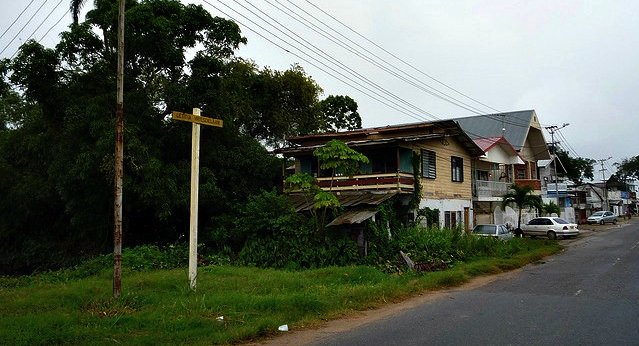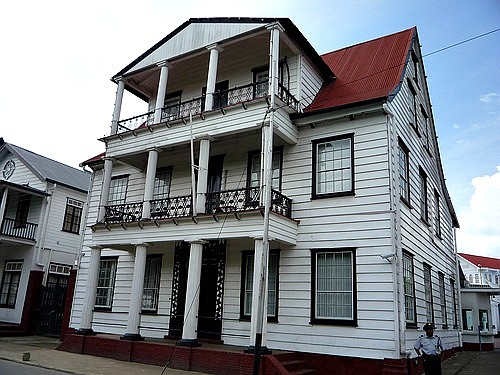 Facebook
Facebook
 X
X
 Instagram
Instagram
 TikTok
TikTok
 Youtube
Youtube

The gravedigger noticed me looking a bit lost among the weeds and snakes of the old cemetery. He shouted to me. "Bakra, over there." I looked up.
"More further," he said, wiping the sweat away from his forehead with his muddy palm while using his other hand to wave toward the back of the graveyard.
I was confused. In short, I was hoping for more information.
What was "Bakra"? My grasp of Sranan Tongo – the lingua franca of Surinam – was explicitly short of nil.
Like a splinter driven between French Guiana and Guyana on the northeastern shoulder of South America, Surinam is not a place generally associated with the Scottish diaspora. But then it is hardly surprising that Scots reached the area, as in the 17th and 18th centuries Scottish emigration was very much in keeping with the age.
Exasperated with my useless interpretation of his directions, the gravedigger scrambled from his trench and moved, disregarding any venomous reptiles hiding amid the overgrowth, until he came to a more antiquated looking set of stone slabs. Pointing, he repeated: "Bakra."
It came to me then – Bakra. White man.
Acknowledged, but not widely recognized, is the Scottish history in Surinam. My helpful gravedigger clearly knew what I was looking for. What else would a European-looking tourist be doing in the graveyard of a town of about 800 residents?
All it had taken was one small and relatively innocuous line in my guidebook stating Totness to be the site of a former Scottish settlement. There was no further information. Moreover, I had yet to meet anyone from Surinam or who had even visited this unknown quantity of a country.
Don't get me wrong; I did not come all the way from Britain just for this. South America is my beat as a journalist, and Surinam was on a short list of places I had yet to visit on the continent. But due to my Scottish ancestry and direct link to the diaspora by virtue of a Scots-Canadian parent, this little project began to take on a personal slant.
Totness – far removed from its namesake in Devon, where it is spelled “Totnes” – is the site of the oldest settlement in Surinam. Just up the way is Burnside, founded in 1808 and the site of the country's oldest plantation. As you check the map, more places with a Caledonian feel are evident: Clyde, Inverness, Hamilton and Perseverance are all sites of Scottish sugar and cotton plantations hugging the Surinam coastline and dating back to the early 1800s.
The districts of Coronie and Nickerie were then collectively referred to as Seacoast – plantations laid out in parcels only accessible by sea.
To discover more of this unusual settlement history, I enlisted the aid of Cynthia Mcleod, a historical novelist from Surinam and third-generation Scottish immigrant. She told me her great-grandfather, Alexander Farrier, arrived in Nickerie in 1810 in what would have been the second wave of Scottish settlers arriving via neighboring Guyana.
Mcleod is the unrivaled authority here on the Scottish plantation history, and yet so much of it is decaying in poorly kept archives and gravesites are being dug over and re-used. I found no real desire from the relevant authorities to explore and preserve this past.

While now remembered as a Dutch colony, Surinam was held under British rule generally from 1799–1816 as a protective measure against Napoleonic expansionist ideas. In these years before emancipation, Scottish farmers were recruited to settle in this strip of jungle and make good the land. Despite the onerous conditions, Scots turned these plantations into profit amid an influx of slave labor and a positive cotton market.
As the demand for cotton declined and the plantations fell abandoned, Dutch farmers were recruited to keep the work going – but the Seacoast schemes eventually collapsed around 1870 amid the end of slavery.
Where are the descendants of the settlers now? Mortality rates were astounding, and many perished of typhus and yellow fever. Women died when giving birth. Searching the National Archives in the capital, Paramaribo, was a heartbreaking experience. Poor care and neglect has rendered many of the records too damaged to read. What becomes clear is that whether their wives died or returned to Scotland, the plantation owners intermarried with slaves and other settlers.
Surinam, known as Dutch Guiana until it became independent in 1975, now boasts an estimated half-million in population stemming from the descendants of African slaves, indentured East Indian laborers, Dutch colonists, Javanese, Chinese immigrants and indigenous Amerindians.
South American in grandeur and Caribbean in flavor, deep in the blend but pivotal to the country's development, is the Scottish strain. After all, why else would there be so many people here with the name Macleod, MacLean, MacIntosh and MacDonald?


The gravedigger noticed me looking a bit lost among the weeds and snakes of the old cemetery. He shouted to me. "Bakra, over there." I looked up.
"More further," he said, wiping the sweat away from his forehead with his muddy palm while using his other hand to wave toward the back of the graveyard.
I was confused. In short, I was hoping for more information.
What was "Bakra"? My grasp of Sranan Tongo – the lingua franca of Surinam – was explicitly short of nil.
Like a splinter driven between French Guiana and Guyana on the northeastern shoulder of South America, Surinam is not a place generally associated with the Scottish diaspora. But then it is hardly surprising that Scots reached the area, as in the 17th and 18th centuries Scottish emigration was very much in keeping with the age.
Exasperated with my useless interpretation of his directions, the gravedigger scrambled from his trench and moved, disregarding any venomous reptiles hiding amid the overgrowth, until he came to a more antiquated looking set of stone slabs. Pointing, he repeated: "Bakra."
It came to me then – Bakra. White man.
Acknowledged, but not widely recognized, is the Scottish history in Surinam. My helpful gravedigger clearly knew what I was looking for. What else would a European-looking tourist be doing in the graveyard of a town of about 800 residents?
All it had taken was one small and relatively innocuous line in my guidebook stating Totness to be the site of a former Scottish settlement. There was no further information. Moreover, I had yet to meet anyone from Surinam or who had even visited this unknown quantity of a country.
Don't get me wrong; I did not come all the way from Britain just for this. South America is my beat as a journalist, and Surinam was on a short list of places I had yet to visit on the continent. But due to my Scottish ancestry and direct link to the diaspora by virtue of a Scots-Canadian parent, this little project began to take on a personal slant.
Totness – far removed from its namesake in Devon, where it is spelled “Totnes” – is the site of the oldest settlement in Surinam. Just up the way is Burnside, founded in 1808 and the site of the country's oldest plantation. As you check the map, more places with a Caledonian feel are evident: Clyde, Inverness, Hamilton and Perseverance are all sites of Scottish sugar and cotton plantations hugging the Surinam coastline and dating back to the early 1800s.
The districts of Coronie and Nickerie were then collectively referred to as Seacoast – plantations laid out in parcels only accessible by sea.
To discover more of this unusual settlement history, I enlisted the aid of Cynthia Mcleod, a historical novelist from Surinam and third-generation Scottish immigrant. She told me her great-grandfather, Alexander Farrier, arrived in Nickerie in 1810 in what would have been the second wave of Scottish settlers arriving via neighboring Guyana.
Mcleod is the unrivaled authority here on the Scottish plantation history, and yet so much of it is decaying in poorly kept archives and gravesites are being dug over and re-used. I found no real desire from the relevant authorities to explore and preserve this past.

While now remembered as a Dutch colony, Surinam was held under British rule generally from 1799–1816 as a protective measure against Napoleonic expansionist ideas. In these years before emancipation, Scottish farmers were recruited to settle in this strip of jungle and make good the land. Despite the onerous conditions, Scots turned these plantations into profit amid an influx of slave labor and a positive cotton market.
As the demand for cotton declined and the plantations fell abandoned, Dutch farmers were recruited to keep the work going – but the Seacoast schemes eventually collapsed around 1870 amid the end of slavery.
Where are the descendants of the settlers now? Mortality rates were astounding, and many perished of typhus and yellow fever. Women died when giving birth. Searching the National Archives in the capital, Paramaribo, was a heartbreaking experience. Poor care and neglect has rendered many of the records too damaged to read. What becomes clear is that whether their wives died or returned to Scotland, the plantation owners intermarried with slaves and other settlers.
Surinam, known as Dutch Guiana until it became independent in 1975, now boasts an estimated half-million in population stemming from the descendants of African slaves, indentured East Indian laborers, Dutch colonists, Javanese, Chinese immigrants and indigenous Amerindians.
South American in grandeur and Caribbean in flavor, deep in the blend but pivotal to the country's development, is the Scottish strain. After all, why else would there be so many people here with the name Macleod, MacLean, MacIntosh and MacDonald?
Comments